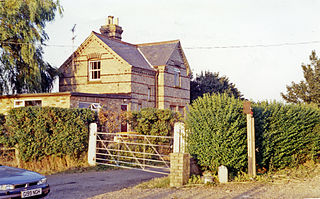
Watlington railway station is on the Fen line in the east of England, serving the village of Watlington, Norfolk. It is 90 miles 70 chains (146.2 km) measured from London Liverpool Street and is situated between Downham Market and King's Lynn stations. Its three-letter station code is WTG.

Tutbury and Hatton Station is a railway station in England, served by trains on the Crewe to Derby Line, which is a Community rail line known as the North Staffordshire line. The station is owned by Network Rail and managed by East Midlands Railway.

Blythe Bridge railway station in Blythe Bridge, Staffordshire, England, is served by trains on the Crewe to Derby Line; it is also a Community rail line known as the North Staffordshire line. The station is owned by Network Rail and managed by East Midlands Railway. The full range of tickets for travel are purchased from the guard on the train at no extra cost.

Longton railway station is a railway station in England at Longton, Stoke-on-Trent. The station is served by trains on the Crewe to Derby Line which is also a community rail line known as the North Staffordshire line. The station is owned by Network Rail and managed by East Midlands Railway. The full range of tickets for travel are purchased from the guard on the train at no extra cost.

Barlaston railway station served the village of Barlaston in Staffordshire, England. This station was opened on 17 April 1848 and is on the first line opened by the North Staffordshire Railway on that date.

Wedgwood railway station served the Wedgwood complex in Barlaston, Staffordshire, England. Although the station is not officially closed, no trains currently call at the station and it is instead served by a rail replacement bus.

Bloxwich railway station serves Bloxwich, in the Metropolitan Borough of Walsall, West Midlands, England. The station, and all trains serving it, are operated by West Midlands Railway.

Bloxwich North railway station serves the town of Bloxwich, in the Metropolitan Borough of Walsall, West Midlands, England. The station, and all trains serving it, are operated by West Midlands Trains.

Cobham & Stoke d'Abernon railway station is in the village of Stoke d'Abernon in Surrey, England and also serves the nearby town of Cobham. It is 18 miles 63 chains (30.2 km) down the line from London Waterloo.
Middle Stoke Halt was a halt on the Hundred of Hoo Railway Uralite Halt and Stoke Junction halt. It was opened in July 1906 and closed to passengers on 4 December 1961.

Abbey and West Dereham railway station was a railway station on the line between Downham Market and Stoke Ferry. It served the village of West Dereham and the nearby St Mary's Abbey, in Norfolk, England. It was located south of the village on what is still called Station Road:

Denver railway station was a station in Denver, Norfolk on the Great Eastern Railway route between King's Lynn and Cambridge, commonly known as the Fen Line. It was also the beginning of a small branch to Stoke Ferry.
Ryston railway station was a railway station serving Fordham, Norfolk. It was on a branch line from Denver.

Egginton Junction railway station is a disused railway station in Egginton, Derbyshire.

Elton railway station is a former railway station in Elton, Cambridgeshire on former Northampton and Peterborough Railway which connected Peterborough with Northampton via Wellingborough.
Piddington was a railway station on the former Bedford to Northampton Line. Despite its name, the station was located close to the village of Horton in Northamptonshire, approximately 2 miles (3.2 km) from the village of Piddington.
Salcey Forest railway station was a short-lived railway station in England, on the Stratford-upon-Avon, Towcester and Midland Junction Railway which opened on 1 December 1892 near the Northamptonshire forest of the same name. The station was not situated near any settlement and only saw passenger services for four months, it being most likely an error of judgement by the railway company which had provided substantial station facilities in expectation of traffic which never came. Salcey Forest station eventually closed on 31 March 1893 and has an arguable claim, along with Stoke Bruerne, of having had the shortest passenger service ever provided at any British railway station. Goods facilities were withdrawn in 1952.

Ipswich Stoke Hill railway station was the northern terminus of the Eastern Union Railway line from Colchester to Ipswich from its opening in June 1846 until 1860 when the present Ipswich station opened at the other end of the Stoke tunnel. It was located in Croft Street, Stoke, Suffolk. Trains from London terminated at the station but from November 1846 when a new line was built by the Ipswich and Bury Railway to Bury St Edmunds trains from Bury used to pass the station, stop at Halifax Junction a short distance to the south and propel back into the terminus usually using the western platform. Trains for Bury would reverse out as far as Halifax Junction before travelling north.

The Wellington and Drayton Railway was a standard gauge line in Central England which carried through freight and local passenger traffic until closure in the 1960s. It was part of the Great Western Railway's double track Wellington-Crewe line, linking the Midlands to the north and northwest.
Inch Road railway station served Magherabeg in County Donegal, Ireland.















